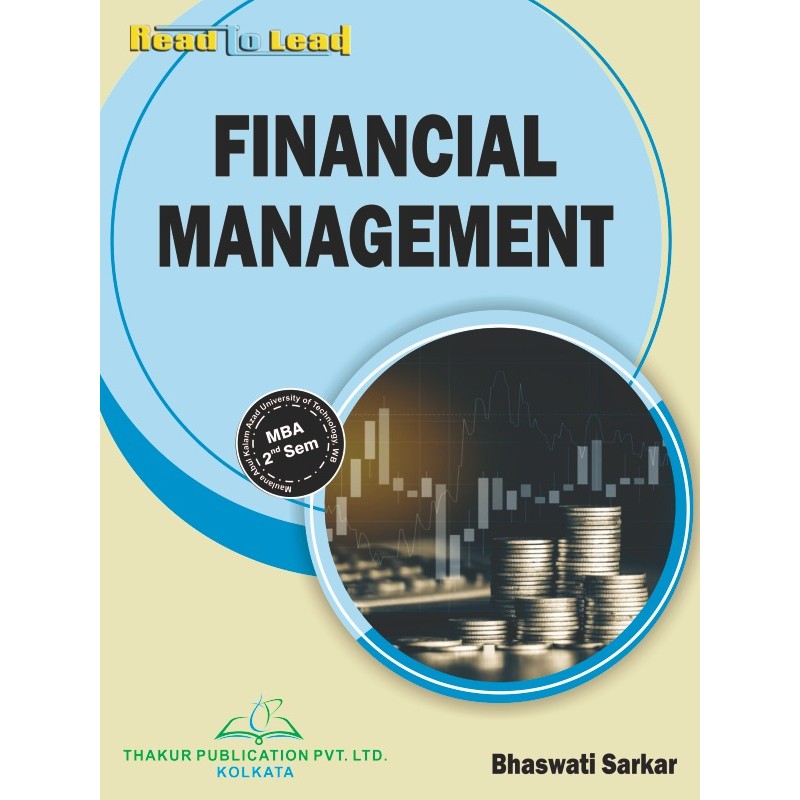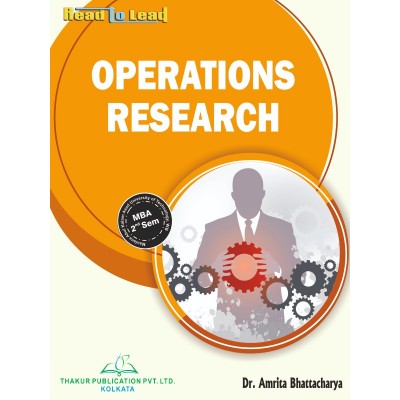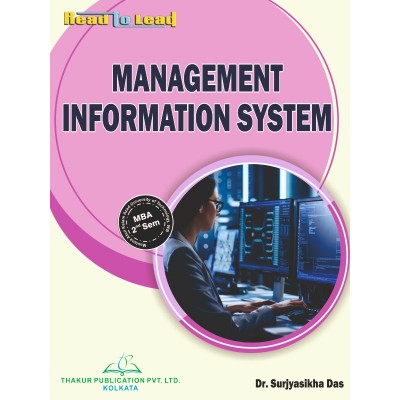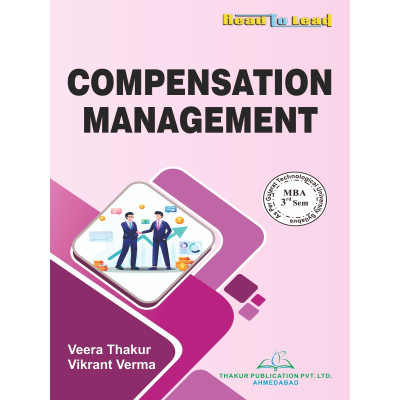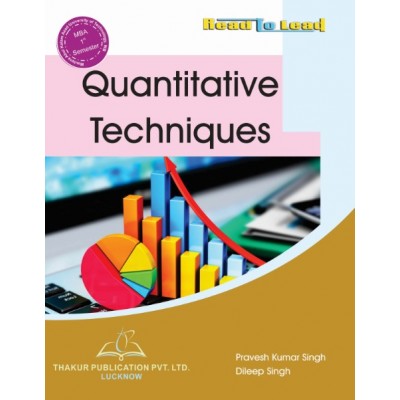FINANCIAL MANAGEMENT MAKAUT MBA SECOND SEM
Tax excluded
Syllabus
MB202:
Financial Management
MODULE-I
1) Introduction to Financial Management: Scope, Objectives, Functions. [2 Lectures]
2) Capital Structure: Concepts, Component of Capital, Leverage, Models of Capital Structure. [6 Lectures]
3) Introduction to Corporate Finance: Meaning of Corporation, Role of Financial Manager, Agency Problem.
[2 Lectures]
4) NPV as Investment Decision Criteria: Comparing NPV with other methods of Investment Decisions, The problems of Multiple Rates of Return, Mutually Exclusive Projects, and Capital Rationing. [4 Lectures]
5) The Investment Decision: The Cash Flow, Equivalent annual Costs, Project Interactions. [4 Lectures]
MODULE-II
6) Capital Budgeting and Risk: Company and Project Costs of Capital, Measuring Cost of Equity, Cost of Capital, and Risk Adjusted Discount Rate, Sensitivity Analysis, Monte Carlo Simulation, Real Options and Decision Trees. [4 Lectures]
7) Alignment of Managers and Owners Goal: Practical aspects of Capital Investment Process, Information and Capital Investment, Incentives and their role in Agency Problem, Measuring and Rewarding Performance: EVA, Pros and Cons of EVA. [4 Lectures]
8) Market Efficiency and Corporate Financing Basics of EMH, The Anomalies, The lessons for the Corporate Manager. [4 Lectures]
9) The Financing Decision: The Financing Process, The Financing Mix: Tradeoffs and Theory, The Optimal Financing Mix, The Financing Mix and Choices. [4 Lectures]
10) The Dividend Decision: Dividend Policy, analyzing Cash Returned to Stockholders, Buybacks, Spinoffs, and Divestures. [4 Lectures]
11) Case Study [2 Lectures]
Contents
<td width="83%" valign="top" style="width:83.28
|
MODULE-1 |
||
|
Chapter 1: Introduction to Financial Management |
||
|
1.1. |
Financial Management |
13 |
|
1.1.1. |
Meaning and Definition of Finance |
13 |
|
1.1.2. |
Meaning and Definition of Financial Management |
13 |
|
1.1.3. |
Scope/Approaches of Financial Management |
13 |
|
1.1.4. |
Objectives of Financial Management |
14 |
|
1.1.5. |
Profit Maximisation |
15 |
|
1.1.5.1. |
Features of Profit Maximisation |
15 |
|
1.1.5.2. |
Arguments in Favour of Profit Maximisation |
15 |
|
1.1.5.3. |
Limitations of Profit Maximisation |
16 |
|
1.1.6. |
Wealth Maximisation |
16 |
|
1.1.6.1. |
Features of Wealth Maximisation |
17 |
|
1.1.6.2. |
Arguments in Favour of Wealth Maximisation |
17 |
|
1.1.6.3. |
Limitations of Wealth Maximisation |
17 |
|
1.1.6.4. |
Profit Maximisation vs. Wealth Maximisation |
18 |
|
1.1.7. |
Functions of Financial Management |
18 |
|
1.1.8. |
Significance of Financial Management |
20 |
|
1.1.9. |
Organisation of Finance Function |
20 |
|
1.1.9.1. |
Functions of CFO as a Treasurer |
21 |
|
1.1.9.2. |
Functions of CFO as a Controller |
21 |
|
1.1.10. |
Functional Areas of Financial Management |
21 |
|
1.2. |
Exercise |
22 |
|
|
|
|
|
Chapter 2: Capital Structure |
||
|
2.1. |
Capital Structure |
24 |
|
2.1.1. |
Concepts of Capital Structure |
24 |
|
2.1.2. |
Optimal Capital Structure |
24 |
|
2.1.3. |
Components of Capital Structure |
25 |
|
2.1.4. |
Factors Influencing Capital Structure |
25 |
|
2.1.5. |
Advantages of Capital Structure |
27 |
|
2.2. |
Models/Theories of Capital Structure |
28 |
|
2.2.1. |
Introduction |
28 |
|
2.2.2. |
Relevance of Capital Structure |
29 |
|
2.2.3. |
Net Income (NI) Approach |
29 |
|
2.2.4. |
Traditional Approach |
31 |
|
2.2.5. |
Irrelevance of Capital Structure |
33 |
|
2.2.6. |
Net Operating Income (NOI) Approach |
33 |
|
2.2.7. |
MM (Modigliani and Miller) Approach/Hypothesis |
36 |
|
2.2.7.1. |
MM Theory: No Taxation |
37 |
|
2.2.7.2. |
MM Propositions |
37 |
|
2.2.7.3. |
Arbitrage Process |
39 |
|
2.2.7.4. |
MM Hypothesis with Corporate Taxation |
40 |
|
2.2.7.5. |
Criticisms of MM Theory |
41 |
|
2.3. |
Leverages |
42 |
|
2.3.1. |
Meaning & Definition of Leverage |
42 |
|
2.3.2. |
Types of Leverage |
42 |
|
2.3.3. |
Financial Leverage |
42 |
|
2.3.3.1. |
Measures of Financial Leverage |
43 |
|
2.3.3.2. |
Degree of Financial Leverage (DFL) |
43 |
|
2.3.3.3. |
Effects/Implications of Financial Leverage |
44 |
|
2.3.3.4. |
Advantages of Financial Leverage |
44 |
|
2.3.4. |
Operating Leverage |
44 |
|
2.3.4.1. |
Measures of Operating Leverage |
44 |
|
2.3.4.2. |
Degree of Operating Leverage (DOL) |
45 |
|
2.3.4.3. |
Effects/Implications of Operating Leverage |
46 |
|
2.3.4.4. |
Advantages of Operating Leverage |
46 |
|
2.3.4.5. |
Difference between Operating and Financial Leverage |
46 |
|
2.3.5. |
Combined/Composite Leverage |
46 |
|
2.4. |
Exercise |
52 |
|
|
|
|
|
Chapter 3: Introduction to Corporate Finance |
||
|
3.1. |
Introduction to Corporate Finance |
55 |
|
3.1.1. |
Meaning of Corporation |
55 |
|
3.1.2. |
Meaning of Corporate Finance |
55 |
|
3.1.3. |
Nature of Corporate Finance |
55 |
|
3.1.4. |
Scope of Corporate Finance |
56 |
|
3.2. |
Finance Manager |
58 |
|
3.2.1. |
Meaning of Finance Manager |
58 |
|
3.2.2. |
Role of Finance Manager |
58 |
|
3.2.3. |
Responsibilities of Finance Manager |
58 |
|
3.2.4. |
Changing Role of Finance Manager |
59 |
|
3.3. |
Agency Problem |
60 |
|
3.3.1. |
Meaning of Agency Problems/Conflicts |
60 |
|
3.3.2. |
Agency Cost |
61 |
|
3.3.3. |
Resolving the Agency Problems |
61 |
|
3.4. |
Exercise |
63 |
|
|
|
|
|
Chapter 4: Investment Decisions |
||
|
4.1. |
Investment Decisions |
64 |
|
4.1.1. |
Meaning and Definition of Investment Decision/Capital Budgeting |
64 |
|
4.1.2. |
Scope of Capital Budgeting |
64 |
|
4.1.3. |
Purpose of Capital Budgeting |
65 |
|
4.1.4. |
Process of Capital Budgeting |
66 |
|
4.1.5. |
Advantages of Capital Budgeting |
66 |
|
4.1.6. |
Difficulties in Capital Budgeting |
67 |
|
4.2. |
Investment Decision Criteria |
67 |
|
4.2.1. |
Payback Period Method |
67 |
|
4.2.1.1. |
Calculation of Payback Period Method |
67 |
|
4.2.1.2. |
Advantages of Payback Period Method |
68 |
|
4.2.1.3. |
Disadvantages of Payback Period Method |
68 |
|
4.2.2. |
Discounted Payback Period |
69 |
|
4.2.2.1. |
Advantages of Discounted Payback Period |
70 |
|
4.2.2.2. |
Disadvantages of Discounted Payback Period |
70 |
|
4.2.3. |
Accounting Rate of Return (ARR) Method |
70 |
|
4.2.3.1. |
Calculation of ARR |
71 |
|
4.2.3.2. |
Advantages of Average Rate of Return Method |
71 |
|
4.2.3.3. |
Disadvantages of Average Rate of Return Method |
71 |
|
4.2.4. |
Net Present Value (NPV) as Investment Decision Criteria |
73
Data sheet |







